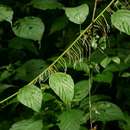en
names in breadcrumbs


Chini icha Tsini (genus Urera) nisqakunaqa huk qurakunam, sisi p'uchquyuq suphunkunawan k'arachiq.
Chini icha Tsini (genus Urera) nisqakunaqa huk qurakunam, sisi p'uchquyuq suphunkunawan k'arachiq.
Urera is a genus of flowering plants in the nettle family, Urticaceae. It has a pantropical distribution.[1]
Urera are lianas,[2] shrubs, and small trees.[1] Climbing species root along the stems and can reach the crowns of the trees they use for support.[2] Some are spiny.[1] They almost always have urticating hairs, often on bumps in the epidermis.[2] These are stiff, stinging trichomes with swollen bases.[1] The leaves are variable in shape and venation, and help in the identification of species. Also useful is the varying appearance and arrangement of cystoliths on the leaf surface. The inflorescence is a divided, branching panicle of flowers. Most species are dioecious, but a few are monoecious. Most species have male flowers with either four or five stamens and tepals.[1] Female flowers generally have four uneven, free to mostly fused tepals. The fruit is an achene covered in orange or red flesh.[2]
About 113 species epithets have been published for the genus.[3] Many species have been transferred to other genera, including Boehmeria, Dendrocnide, Girardinia, Gyrotaenia, Laportea, and Obetia. It is not clear how many valid species currently belong in Urera, with estimates ranging from 17[4] to 75.[1] The genus is not well known, with current knowledge dependent mainly on outdated studies, and there is little agreement regarding its taxonomy.[1]
The genus Urera was first described by Charles Gaudichaud-Beaupré in 1826 in his review of the studies done on Louis de Freycinet's voyage of the Uranie.[5] He noted its distinctness, proposing the subtribe Urereae. This was later raised to the rank of tribe,[6] and subsequently merged into Urticeae.[7]
Urera was expanded to include the monospecific genus Scepocarpus.[7] Analysis of trnL-F chloroplast DNA sequence data suggests that Urera could be sister to Poikilospermum within the Urticaceae.[8]
No botanical monographs have been devoted to Urera since 1869.[1] Knowledge of the systematics of the genus has accumulated mainly from new descriptions of species and floristic accounts.[1]

Species include:[4]
Urera is a genus of flowering plants in the nettle family, Urticaceae. It has a pantropical distribution.
Urera es un género con 110 especies de plantas de flores perteneciente a la familia Urticaceae.
Son hierbas grandes, arbustos o árboles pequeños ocasionalmente escandentes (o lianas), frecuentemente con tricomas urticantes dispersos o espinas urticantes puntiagudas; plantas monoicas o dioicas. Tiene hojas alternas, enteras, serradas o profundamente lobadas, con cistolitos punctiformes o cortamente lineares, generalmente pinnatinervias; las estípulas en pares, libres o más o menos fusionadas alrededor de la base del pecíolo. Las inflorescencias son paniculadas, cimosas o simples sólo con unas pocas flores agrupadas, axilares o caulifloras; las flores masculinas con perianto 4 o 5-partido; las flores femeninas con perianto 4-partido, estigma generalmente penicilado (linear en U. laciniata), persistente en el fruto. El fruto es un aquenio al menos parcialmente rodeado por el perianto agrandado y carnoso, abayado en el material fresco, delgado y en forma de bráctea en el material seco, aplicado al fruto y encerrándolo o abrazándolo.
Urera es un género con 110 especies de plantas de flores perteneciente a la familia Urticaceae.
Urera est un genre de plantes de la famille des Urticaceae.
Selon Catalogue of Life (16 octobre 2017)[2] :
Selon GRIN (16 octobre 2017)[3] :
Selon ITIS (16 octobre 2017)[4] :
Selon NCBI (16 octobre 2017)[5] :
Selon The Plant List (16 octobre 2017)[6] :
Selon Tropicos (16 octobre 2017)[1] (Attention liste brute contenant possiblement des synonymes) :
Urera est un genre de plantes de la famille des Urticaceae.
Urera é um género botânico pertencente à família Urticaceae.
A autoridade científica do género é Gaudich., tendo sido publicado em Voyage autour du monde, entrepris par ordre du roi, . . . éxécuté sur les corvettes de S. M. l'Uranie et la Physicienne, pendant les années 1817, 1818, 1819 et 1820; . . . Botanique 496–497. 1826 (1830).[1]
De acordo com a base de dados The Plant List o género tem 140 espécies descritas das quais 43 são aceites.[2]
Urera é um género botânico pertencente à família Urticaceae.
A autoridade científica do género é Gaudich., tendo sido publicado em Voyage autour du monde, entrepris par ordre du roi, . . . éxécuté sur les corvettes de S. M. l'Uranie et la Physicienne, pendant les années 1817, 1818, 1819 et 1820; . . . Botanique 496–497. 1826 (1830).
Urera là chi thực vật có hoa trong họ Tầm ma.[1]
Chi này gồm các loài:
Urera là chi thực vật có hoa trong họ Tầm ma.